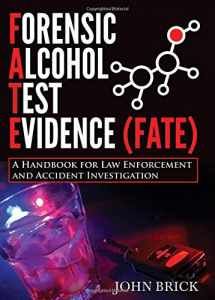
Forensic Alcohol Test Evidence (FATE): A Handbook for Law Enforcement and Accident Investigation
Book details
Summary
Description
Everyday problems associated with the consequences of alcohol use disorders require answers, and it is for this reason Forensic Alcohol Test Evidence (FATE) was written. Forensic alcohol test evidence focuses on the evaluation, interpretation and application of the effects of alcohol or an alcohol test result to some legal issue such as a crime, accident or consequence of alcohol exposure. In FATE, many of the issues pertinent to a thorough forensic evaluation and trial testimony are discussed, but most importantly is the focus on consistent, unbiased, and comprehensive application of diverse scientific disciplines and research to questions of forensic interest. This requires evaluating behavioral, analytical, physiological, pharmacological and toxicological evidence in the puzzle; determining if the pieces go together; and reaching a conclusion to a reasonable degree of scientific certainty. The first chapter discusses what is forensic alcohol test evidence and why it is studied. Chapter 2 explores forensic alcohol evidence and what are the types of alcohol and quantitative expression of blood alcohol. Chapter 3 examines alcohol pharmacokinetics, alcohol pharmacodynamics site of alcohol action, and basic neurophysiology. Neuropharmacology of alcohol intoxication is also discussed. Chapter 4 covers laboratory and clinical-based tests of impairment. In Chapter 5, DWI high-risk behaviors and injuries are discussed. Chapter 6 defines alcohol and the law: drunk driving, visible intoxication, and aggression, while Chapter 7 covers the DWI investigation and arrest, elements of the DWI report, outside vehicle test, and obtaining blood samples. Chapters 8 and 9 describe alcohol-drug interactions and medical consequences and toxicological considerations. Chapters 10 and 11 pursue alcohol use, tolerance, dependence, and the need for standardization and estimating blood alcohol levels. The remaining two chapters cover accident reconstruction and neuropsychology. This book will be an essential tool and valuable resource for all law enforcement officers and investigators, forensic examiners and other professionals in the evaluation and interpretation of alcohol evidence in crimes and accidents.


We would LOVE it if you could help us and other readers by reviewing the book
Book review



